(UPDATED at 3:26 p.m. MDT, July 24, 2013)
The incident management team released this information Wednesday afternoon:
Lander, Wyo. (July 24, 2013) – A public meeting for the Fairfield Fire will be held at 7:00pm this evening at the Lander Middle School, 755 Jefferson St., Lander, Wyo. This meeting will be an opportunity for the public to learn what actions have been taken on the fire thus far and what the plan ahead is.
Following an infrared flight last night, a more precise perimeter was able to be determined. This allowed the Rocky Mountain Incident Management Team, who took over command of the fire late yesterday, to develop a more accurate map. The fire is 15 percent contained with a total size of 1,909 acres. The cause of the fire remains under investigation by a Fremont County firefighter and Forest Service officials.
Some local initial attack resources have been released from the fire. A total of 138 personnel are currently on the fire along with 6 single engine air tankers, 2 light helicopters, and 2 heavy helicopters.
The National Weather Service has established a “decision support” web page for the fire.
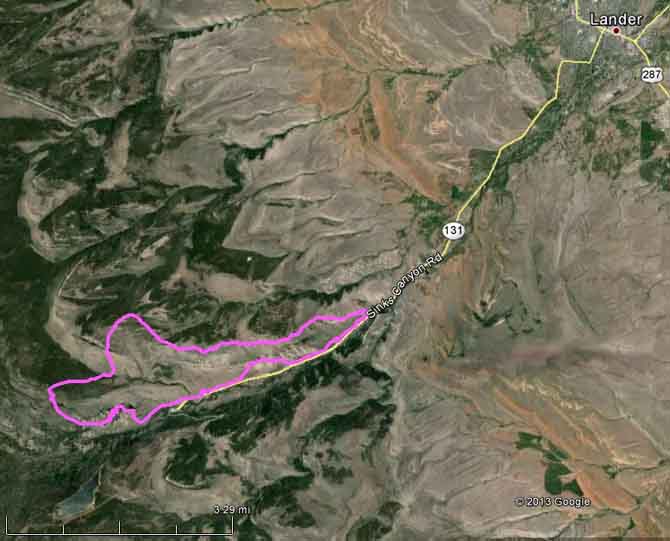
The Fairfield Fire continued to spread on the west side over the last 24 hours as it climbed into the higher elevations, finding more continuous stands of timber.
The weather forecast for Wednesday predicts weather similar to Tuesday’s, with easterly up canyon winds at 5 to 10 mph, 15 to 20 percent relative humidity, 30 to 65 percent cloud cover, and a chance for thunderstorms with little or no rain.
****
(UPDATED at 5:52 p.m. MDT, July 23, 2013)
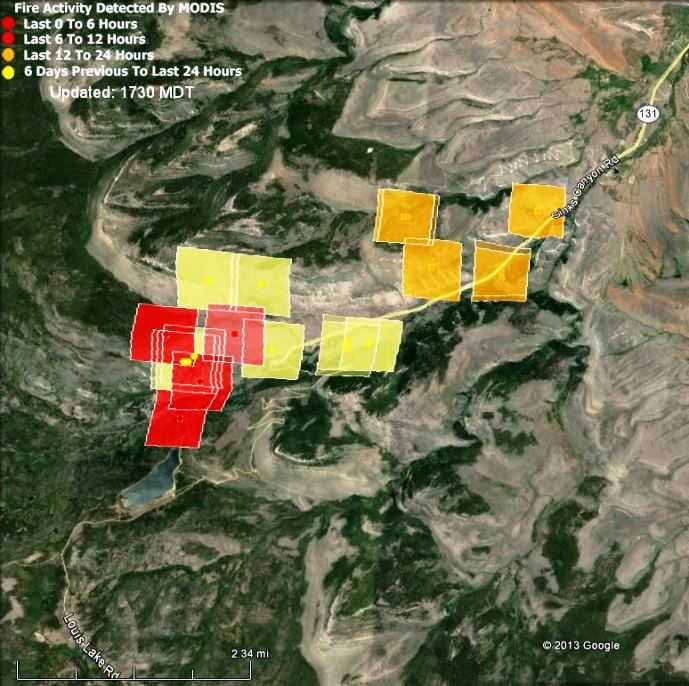
The east winds showed up a predicted and pushed the Fairfield fire toward the west near Frye Lake. The Shoshone National Forest sent this tweet at 5:26 p.m. Tuesday:
#FairfieldFire has increased to 1686 acres with growth seen on the western edge today.
— Shoshone Forest (@ShoshoneNF) July 23, 2013
The Rocky Mountain Type 2 Incident Management Team A has been assigned to the fire.
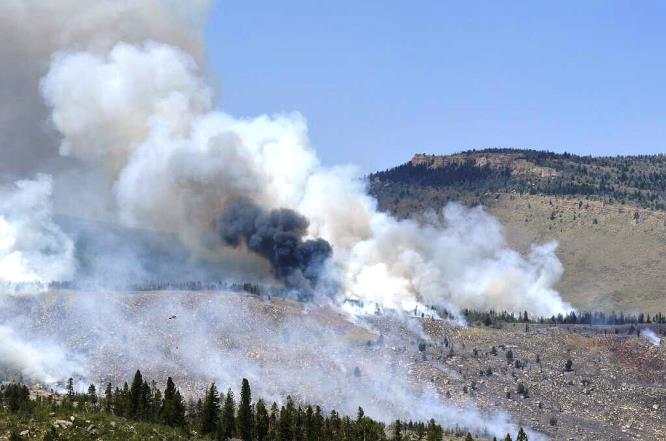
****
(UPDATED at 11:30 a.m. MDT, July 23, 2013)
The Fairfield Fire was very active Monday night spreading toward the northeast. The 1,200-acre fire is now about six miles southwest of Lander, Wyoming. In the maps of the fire below, the squares indicate the location of heat detected by a satellite at 2 a.m. Tuesday, with the red ones being the most recent. The location of each square can be as much as a mile in error.
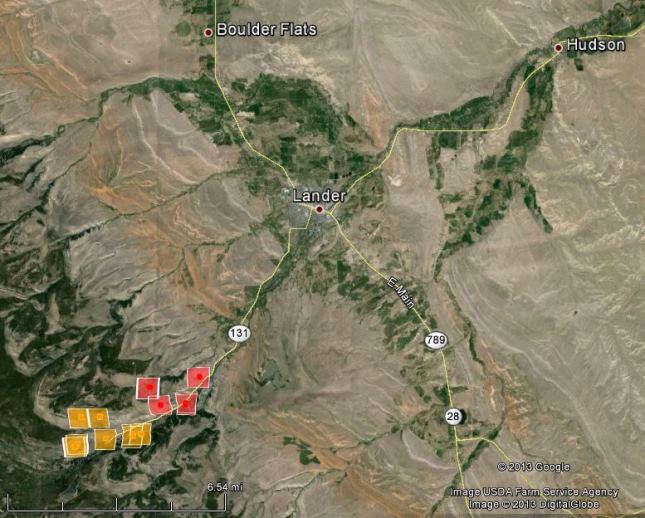
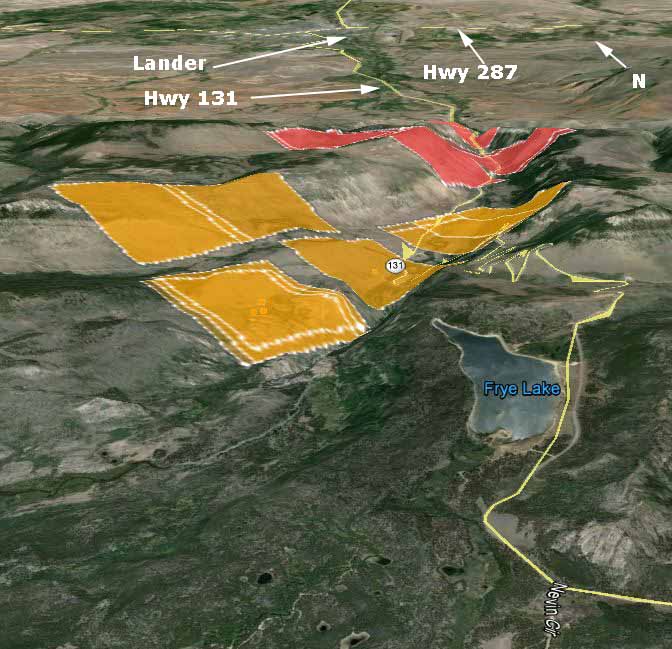
Al told us about a new weather station in Sinks Canyon that is much closer than the Wind River weather station. In fact it is literally in the middle of the fire. We don’t know to what degree the fire is affecting the weather there, but it shows the maximum relative humidity last night was only 26 percent which helps to explain why the fire was active throughout the night. The wind changed direction at 8:30 a.m. Tuesday, switching from west to east at 4 to 8 mph gusting to 10. The forecast predicts east and northeast winds during the afternoon on Tuesday, which would tend to push the fire into the higher elevations where there is more continuous timber, increasing the resistance to control.
The spot weather forecast for the fire was produced about seven hours after it was requested. This compares to the six-minute turnaround for the last spot forecast on the fatal Yarnell Hill Fire before the burnover on June 30.
There are several good-sized lakes near the fire, with one being less than a mile away. This fire appears to be an excellent candidate for scooper air tankers.
In the photo below, I was wondering about those light colored spots at regular intervals adjacent to the retardant. When viewed on Google Earth and Google Maps, at 42.746798° -108.833208°, it is obvious that they are the locations of structures along Lander Mountain Road.
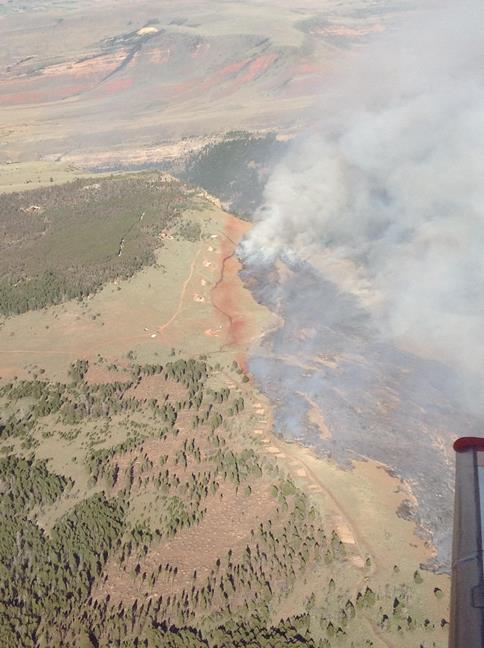
****
(Originally published at 9 p.m. MDT, July 22, 2013)
The Fairfield Fire was reported around noon Monday but by 3:10 p.m. a Type 2 Incident Management Team had already been ordered. As you can see in the map of the fire below it is 9 miles southwest of Lander, Wyoming. It is near Sinks Canyon Road (Hwy. 131). The video above appears to have been taken not long after it started.
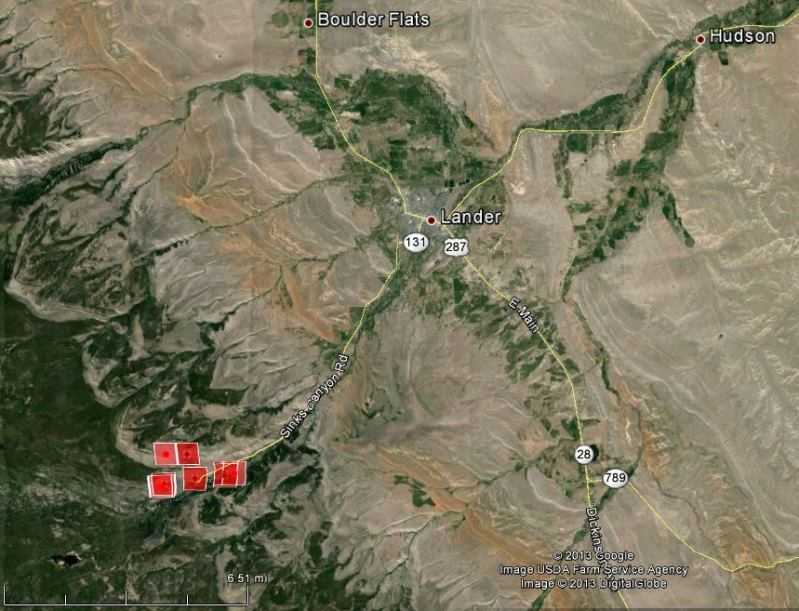
According to the Rocky Mountain Coordination Center, some of the resources dispatched within the first hour were two Single Engine Air Tankers, one DC-10 Very Large Air Tanker, and one lead plane. Structures were threatened and evacuations of Homestead Park and Sinks Canyon Campgrounds were in progress by 1:10 p.m.
The tweet below is from a reporter for KTWO-TV in Casper at 8:32 p.m. Monday.
The USFS tells our Fremont County bureau reporter that the #FairfieldFire has now burned at least 700 acres.
— Taylor Viydo (@TaylorViydo) July 23, 2013
The relative humidity recorded at the Wind River weather station 20 miles north of the fire and about 1,000 feet higher in elevation, was in the single digits Monday afternoon, reaching a low of 6 percent. The forecast for the fire area for tonight calls for 15 to 20 mph west winds gusting to 24 with poor humidity recovery. For Tuesday the temperature will be in the mid-80s and the winds should be much calmer, at around 6 to 8 mph out of the north and northeast, with the relative humidity in the low teens in the afternoon.
An article at County10 said 36 hours before the fire was reported, campers saw a burning meteorite land in the general area where the fire later started:
…Scott and Tasha Fitzgerald of Arkansas were camping in a Forest Service campground for several days and were forced to evacuate. The couple told County10.com that at about 11:30 p.m. on Saturday they observed a “huge meteor” land in the vicinity of Fairfield Hill. Scott Fitzgerald said it appeared to still be burning when it struck the ground.
“That was the first thing that come to me,” Scott Fitzgerald said of when he first found out about the fire.
Thanks go out to Dustin


Nice reply OCR.
But wait, gotwood4sale! !
Don’t dismiss your wit so lightly…
You describe a meteor rightly…
And when a “falling star” does so alight…
It then becomes a meteorite…
I guess a fire, it could ignite…
http://en.wikipedia.org/wiki/Meteorite
OCR… lol
From the ‘Wikipedia’ entry Meteorite…
“Few meteorites are large enough to create large impact craters. Instead, they typically arrive at the surface at their terminal velocity and, at most, create a small pit.”
If, following a thorough investigation, the source of the Fairfield Fire turns out to be “fire escaped from a fire pit” I would suggest taking a close second look at the pit itself!
“One of those rocks is not like the others,
One of those rocks just doesn’t belong,
Can you tell which rock is not like the others
By the time I finish my song?”
The river runs into the mountain on the south side of the 131 and comes out on the north side if the 131 about a 1/4 to 1/2 mile east. Some of the biggest trout I’ve ever seen right where it pops out on the north side. If it starts heading n/w, lots of wilderness. There are lots of lakes up top, but might be tight for scoopers.
Was it a meteorite that did ignite? Or merely a meteor that didn’t score?
What?
Don’t worry Bill. My ‘headscratcher’ of a response was me trying to be clever. It was obviously a failed attempt.
As stated in the articles some campers in the vicinity of the fire reported seeing a meteor before the fire started. They speculated that the cause of the fire may have been a meteor. And that is what prompted my less than clever response. In order for a meteor to become an ignition source it must become a meteorite (a meteoroid that has impacted the earth’s surface). My less than clever response was a very indirect attempt at distinguishing between a meteor, meteoroid, and a meteorite and their ability or inability to cause a wildfire. That’s all.